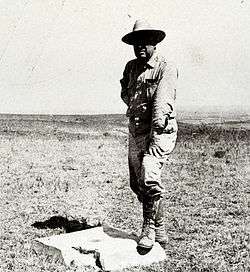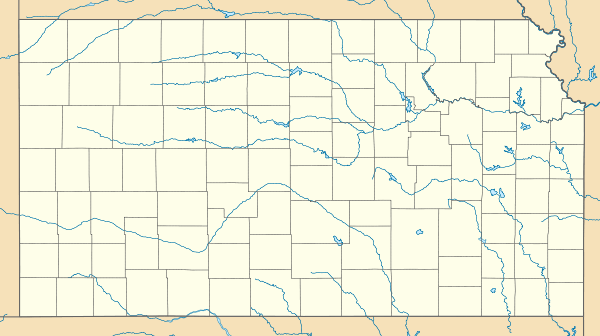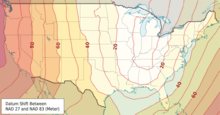Meades Ranch Triangulation Station
The Meades Ranch Triangulation Station is a survey marker in Osborne County[2] in the state of Kansas in the Midwestern United States. The marker was initially placed in 1891; from 1901 to 1989, it was the reference location relative to which all locations in the United States were measured, and from 1913 to 1989, it was the reference location for all surveys in the continent.
Geodetic Center of the U.S. | |
 Meades Ranch triangulation station, ca. 1940 | |
 Location of Meades Ranch in Kansas | |
| Nearest city | Osborne, Kansas |
|---|---|
| Coordinates | 39.224087°N 98.542152°W |
| Built | 1891 |
| NRHP reference No. | 73000772[1] |
| Added to NRHP | October 9, 1973 |
In 1973, the site was listed in the National Register of Historic Places as Geodetic Center of the United States.
History
In surveying, a geodetic datum is a point or set of points used to establish a coordinate system. By designating the location of one point, and the direction from that point to a second point, one can establish a system relative to which other points can be located and mapped. As one surveys a larger area over which the curvature of the Earth becomes significant, it also becomes necessary to define an ellipsoid: a curved surface that approximates the shape of the Earth in the area of interest.[3][4]
The first nationwide datum in the United States was established in 1879. At that time, a region of contiguous triangulation existed from Maine to Georgia. The New England Datum was chosen with a benchmark in Maryland, near the middle of this region, as the horizontal datum, and a second Maryland mark used to define the azimuth (horizontal) direction.[5] To account for the Earth's curvature, the datum used a model called the Clarke spheroid, developed in 1866.[6]
Meades Ranch station
The U.S. Coast and Geodetic Survey established a triangulation station, officially known as the Meades Ranch Triangulation Station, in 1891. The location lay near the intersection of two transcontinental arcs of triangulation: one running from the Atlantic to the Pacific Ocean, roughly following the 39th parallel; the other running from Mexico to Canada, along the 98th meridian.[2][7][8]
In 1901, the Meades Ranch station was chosen as the United States standard horizontal datum: the point relative to which all land measurements in the nation were made. The choice was based on the station's location near the geographic center of the U.S. and near the intersection of the two arcs of triangulation, and because it minimized the number of changes in previously published positions. Its position was officially set as 39°13'26.686" N and 98°32'30.506" W; the azimuth direction to a triangulation station near Waldo, southwest of Meades Ranch, was officially set as 75°28'14.52" west of south.[2][5][7]
In 1913, the chief astronomer of the Dominion of Canada Astronomical Observatory and the director of the Comisión Geodésica Mexicana announced that their organizations would use the Meades Ranch location as their standard datum. In light of this, its name was changed to the "North American Datum".[7]

As more new surveys and previously isolated survey networks were incorporated into the system, it became increasingly difficult to make the necessary corrections. By the mid-1920s, it was realized that the coordinate system needed to be adjusted. From 1927 to 1932, the approximately 25,000 existing control locations were recalculated and a new coordinate system developed, known as NAD27. The new system continued to use the 1901 coordinates of Meades Ranch as its horizontal datum, and the Clarke spheroid as its model for the Earth's surface. However, it now defined horizontal directions in terms of 175 Laplace azimuths, which use astronomical azimuths corrected for the difference between the astronomic and geodetic meridians. Under NAD27, the azimuth to the Waldo station changed by about 5".[4][5][6][9][10]
In 1973, the Meades Ranch site was added to the National Register of Historic Places, under the name "Geodetic Center of the United States".[11]
NAD83
Following the establishment of NAD27, it was noted that it produced a discrepancy of about 10 meters (33 ft) in latitudes in the northern part of the northern U.S. state of Michigan, necessitating a regional adjustment for the states of Michigan and Wisconsin. As the survey network was extended further north into Canada, similar discrepancies appeared. The problem proved to be systemic: It had been assumed that the differences between the Clarke spheroid and the actual geoid were negligible, whereas these differences actually introduced significant errors. The relatively small number and large separation of the points used to develop NAD27, the limited computational power available to its designers, and the movement of tectonic plates also led to inconsistencies in NAD27 coordinates.[6][12]

To address these, a new datum was developed, designated NAD83. It replaced the Clarke spheroid with a new ellipsoid, the Geographic Reference System 1980, centered at the Earth's center of mass as determined by the Bureau International de l'Heure. The new datum was based on adjustment of 250,000 points, including 600 satellite Doppler stations. NAD83 was officially adopted by the U.S. government in 1989, and by the Canadian government in 1990. Under the new system, Meades Ranch lost its special standing, and became one of thousands of stations.[10][13][14][15]
Description
As of 2012, the location of the Meades Ranch station was 39°13′26.71220″N 98°32′31.74540″W. It lies about 12 miles (19 km) north of Lucas and about 10 miles (16 km) southwest of Tipton.[16]
The station is on a low grassy ridge in a pasture. It is marked by a bronze disc, inscribed "Meades Ranch 1891", embedded in the top of a dome-shaped concrete marker 21 inches (53 cm) in diameter, rising about 4 inches (10 cm) above ground level. Two reference marks and an azimuth mark are located nearby.[2][16]
The Meades Ranch station is on private land, with no public access.[17] A replica of the station marker, with a Kansas historical marker explaining its significance, is located at 39.452286°N 98.693542°W, in a roadside rest area beside U.S. Highway 281 at the northern edge of Osborne, Kansas, 18 miles (29 km) northwest of the Meades Ranch site.[18]
See also
References
- "National Register Information System". National Register of Historic Places. National Park Service. July 9, 2010.
- Pankratz, Richard (1973). "National Register of Historic Places Inventory — Nomination Form: Geodetic Center of the U. S." (PDF). National Park Service. Retrieved 2015-05-12. Two photos circa 1950
- Clynch, James R. "Introduction to Datums". University of New South Wales, Satellite Navigation and Positioning Lab. Archived 2015-01-25 at the Wayback Machine Retrieved 2015-05-11.
- "Chapter IV: Geodetic Systems" in Geodesy for the Layman, 1959. Retrieved 2015-05-11.
- Dracup, Joseph F. "Geodetic Surveys in the United States: The Beginning and the Next One Hundred Years". NOAA. Retrieved 2015-05-11.
- Jiwani, Z. A., and K. M. Kelly. "History of NAD27 and Subsequent Readjustments In Ontario". Ontario Land Surveyor, Fall 1983, pp. 10–15. Retrieved 2015-05-11.
- US Coast & Geodetic Survey, "Triangulation in Kansas", Special Publication No. 70 (1921). Retrieved 2015-05-10.
- Schoewe, Walter H.. "Kansas and the geodetic datum of North America". Transactions of the Kansas Academy of Science 51 (1948) 117–124, www.jstor.org
- Hamilton, John. "Azimuths in Control Surveys". Retrieved 2015-05-11.
- Penry, Jerry. "Meades Ranch". Archived 2015-05-11 at the Wayback Machine Nebraska Surveying. Retrieved 2015-05-11. Archived 2015-05-11 at Wayback Machine.
- "National and State Registers of Historic Places: Osborne County". Kansas Historical Society. Retrieved 2015-05-11.
- Schwarz, Charles R. "The Need for a New Adjustment" in North American Datum of 1983, NOAA Professional Paper NOS2, pp. 9–10. Retrieved 2015-05-11.
- "Impact of NAD83 Adoption". Archived 2015-03-26 at the Wayback Machine Alberta Environment and Sustainable Resource Development. Archived 2014-10-18 at the Wayback Machine Retrieved 2015-05-11.
- "FAQs". NOAA. Retrieved 2015-05-11.
- "Affirmation of Datum for Surveying and Mapping Activities". NOAA. Retrieved 2015-05-11.
- "The NGS Data Sheet: Meades Ranch Reset". NOAA. Retrieved 2015-05-11.
- "Geodetic Center Tour '08 at Meades Ranch". Archived 2008-05-13 at the Wayback Machine Kansas Society of Land Surveyors. Retrieved 2015-05-11. Archived 2008-05-13 at Wayback Machine.
- "Kansas Historical Markers". Kansas Historical Society. Retrieved 2015-05-11. Archived 2015-03-19 at Wayback Machine.
External links
- 1940 re-installation
- At the geodetic center of North America two journal essays